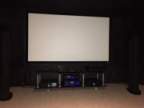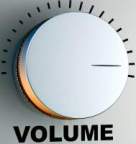- home Forum
- arrow_forward
- Support
- arrow_forward
- Triton Series
- arrow_forward
- Safe watts considering ohms
 Safe watts considering ohms
Safe watts considering ohms
-
 Offline
school
Offline
school
- Junior Member
-

- Posts: 39
- Thank you received: 76
- arrow_drop_downMore arrow_drop_upLess
Eric Tichi
Posted
8 years 11 months ago
Last edit: 8 years 11 months ago by Eric Tichi.
info_outline
#13829
I would love to power my triton fives with a more powerful amp. Like around 350 - 400 watts at 8ohm. Now correct me if I am wrong here. When running a signal the ohm parameter is not a constant but a variable. So when listening a very dynamic medium the ohms may drop thus pulling more watts since there is less resistance. We all see the ratings on amps for 8, 4, and sometimes 2 ohms with their associated watts. Am I overthinking this? My concern is I buy a 400 watt capable amp but the 4 ohm rating will over power the speakers under certain conditions.
Please clear my concern and/or ignorance.
Thanks
Please clear my concern and/or ignorance.
Thanks
Play it loud.
Emotiva UMC-200
Parasound A21
Parasound A23
Triton 5 L/R
SuperCenter XXL
Dayton 18 sealed (DIY)
Emotiva UMC-200
Parasound A21
Parasound A23
Triton 5 L/R
SuperCenter XXL
Dayton 18 sealed (DIY)
The following user(s) said Thank You: T Cobe
Please Log in or Create an account to join the conversation.
-
 Offline
Offline
- Platinum Member
-

- arrow_drop_downMore arrow_drop_upLess
GDHAL
Posted
8 years 11 months ago
Hey Eric. Honestly, you may be overthinking this. While you are correct that the speakers impedance is a variable (en.wikipedia.org/wiki/Nominal_impedance#Loudspeakers), it is for this very same reason that GET provides a "nominal impedance". That value basically does the homework for you by "averaging" (layman's term, not a true average). Use the nominal impedance stated in the GET manual AND the recommended amplification also in the manual as your guide. The thing to be cautious about when cranking up the amp is to remain very mindful of the source material the amp is amplifying. For example, at high wattage normal music passages should be fine but test tones at a specific frequency can do a world of damage.
Golden Ear Triton Reference (pair), Musical Fidelity M6si, Schiit Yggdrasil-OG-B, Oppo UDP-205, Emotiva ERC-3, LG OLED65C9PUA, Salamander Synergy Triple Unit SL20, Audeze LCD-X, GIK acoustic paneling
halr.x10.mx/TritonReference.htm ; halr.x10.mx/other.html
halr.x10.mx/TritonReference.htm ; halr.x10.mx/other.html
The following user(s) said Thank You: T Cobe
Please Log in or Create an account to join the conversation.
-
 Offline
school
Offline
school
- Junior Member
-

- Posts: 39
- Thank you received: 76
- arrow_drop_downMore arrow_drop_upLess
Eric Tichi
Posted
8 years 11 months ago
Thanks man. Good info and advice.
Another thought that has been swimming in my head is the role of an external subwoofer used in conjunction with our speakers. From my understanding, lower registers require more power due to the size of the involved driver. When running in stereo with external (dual) subwoofers, how much 'better' can I drive these speakers than the amp I am using now, an Anthem MCA50 (around 200 watts drink two channels)?
Hypothesis: A 350 watt by 2 amp driving from around 65 hz and up would be approximately the same sonically as a comparable built amp hat has 200 watts by 2.
Would you agree or disagree with that gander?
Another thought that has been swimming in my head is the role of an external subwoofer used in conjunction with our speakers. From my understanding, lower registers require more power due to the size of the involved driver. When running in stereo with external (dual) subwoofers, how much 'better' can I drive these speakers than the amp I am using now, an Anthem MCA50 (around 200 watts drink two channels)?
Hypothesis: A 350 watt by 2 amp driving from around 65 hz and up would be approximately the same sonically as a comparable built amp hat has 200 watts by 2.
Would you agree or disagree with that gander?
Play it loud.
Emotiva UMC-200
Parasound A21
Parasound A23
Triton 5 L/R
SuperCenter XXL
Dayton 18 sealed (DIY)
Emotiva UMC-200
Parasound A21
Parasound A23
Triton 5 L/R
SuperCenter XXL
Dayton 18 sealed (DIY)
The following user(s) said Thank You: T Cobe
Please Log in or Create an account to join the conversation.
-
 Offline
Offline
- Moderator
-

- Posts: 3359
- Thank you received: 3422
- Karma: 19
- arrow_drop_downMore arrow_drop_upLess
Moderator
Posted
8 years 11 months ago
Hi Eric, not sure I understand your questions. But, here are some points for you:
1) Bass takes lots of power due to the nature of those "big" frequencies, has nothing to do with the driver size.
2) If you add a powered subwoofer and eliminate some bass from the main speakers (bass management), the speakers will require significantly less power to drive to high volumes.
3) If you add a subwoofer but don't use bass management, there will be no change in power needs for the main speakers.
4) More amp power is like horsepower in a car, it may be able to make the car go 200+ mph, but few really care about that, we only care about what it does when we want to jump from say, 20-80 mph. If you want really loud, buy a PA. If you want really dynamic and low distortion, buy as big an amp as you can afford but be mindful of the speakers' power handling in use.
1) Bass takes lots of power due to the nature of those "big" frequencies, has nothing to do with the driver size.
2) If you add a powered subwoofer and eliminate some bass from the main speakers (bass management), the speakers will require significantly less power to drive to high volumes.
3) If you add a subwoofer but don't use bass management, there will be no change in power needs for the main speakers.
4) More amp power is like horsepower in a car, it may be able to make the car go 200+ mph, but few really care about that, we only care about what it does when we want to jump from say, 20-80 mph. If you want really loud, buy a PA. If you want really dynamic and low distortion, buy as big an amp as you can afford but be mindful of the speakers' power handling in use.
The following user(s) said Thank You: rjohn79395, T Cobe
Please Log in or Create an account to join the conversation.
-
 Offline
Offline
- Platinum Member
-

- Posts: 2301
- Thank you received: 4381
- Karma: 5
- arrow_drop_downMore arrow_drop_upLess
T Cobe
Posted
8 years 11 months ago
Great questions and responses by all. Just a few bits to add. Doubling in power is only going to net about 3dB in peak volume (top speed). You may actually take a step backwards if you replaced your quality 200 watt amp with a cheaply made 400 watt amp (not that this is what your looking to do, Eric). It would be good to be able to demo any upgrade one is considering.
Besides sound, what are the most important technical specifications to look for when considering a new amp? There is a lot of information out there: wattage, size of power supply, capacitance, speaker dampening, crosstalk, SNR, THD, 4 or 2 ohm stability, etc. Seems like all of these can help get you in the right ballpark if you know what to look for; keeping in mind the most important factor is sound quality.
Cheers,
T Cobe
Besides sound, what are the most important technical specifications to look for when considering a new amp? There is a lot of information out there: wattage, size of power supply, capacitance, speaker dampening, crosstalk, SNR, THD, 4 or 2 ohm stability, etc. Seems like all of these can help get you in the right ballpark if you know what to look for; keeping in mind the most important factor is sound quality.
Cheers,
T Cobe
Speakers: Triton One L/R, SCXL, Aon 3 Surr/Back, HTR-7000 Height
Pre/Pro/AVR: Anthem AVM 60, Emotiva XSP-1
Amps: Emotiva XPA-5(2), Emotiva XPA-1L (2)
Sources: Oppo BDP-103D, Emotiva ERC-3, PS4, Pioneer PLX-1000 w/Ortofon 2M Bronze
Display: Epson 6030 UB, Elite Screens 110" Sable
Pre/Pro/AVR: Anthem AVM 60, Emotiva XSP-1
Amps: Emotiva XPA-5(2), Emotiva XPA-1L (2)
Sources: Oppo BDP-103D, Emotiva ERC-3, PS4, Pioneer PLX-1000 w/Ortofon 2M Bronze
Display: Epson 6030 UB, Elite Screens 110" Sable
Please Log in or Create an account to join the conversation.
-
 Offline
Offline
- Elite Member
-

- Posts: 179
- Thank you received: 337
- arrow_drop_downMore arrow_drop_upLess
murphyslaw1978
Posted
8 years 11 months ago
Hi Eric,
You are correct that if you look at the resistance of the speakers across the entire frequency range, the resistance changes, and it can often be plotted on a graph. There could be peaks as high as 20 ohms or dips as low as 3 or even lower for some speakers. However, wattage may not change all that much even with these wild swings because at high Ohms, the driver might be more efficient and still be able to produce the same SPL level and the current (Amperage) goes down. Volt X Amps = Watts. When you see dips below 8 or 6 or 4 ohms, it's the current that goes up because the voltage has dropped.
The reason why this matters has to due to how well the amplifiers handle high current demands, which is usually a function (or is limited by) the power supply system in the amplifier. Amplifiers can usually only supply a certain amount of voltage up to a limit and not much beyond that limit. So the other factor then becomes current. An amplifier rated at 350 watts into 8 ohms can usually only double down to produce 700 watts into 4 ohms if the power supply system can handle a doubling of current to keep the voltage the same. The result in this case, though, is a noticeable increase in loudness going from 350 watts to 700 watts. I'm talking about 3dB increase, or about 50% louder.
It is rare for an amplifier to double down at all from 8 to 4 ohms, and even more rare to double down again to 2 ohms, but they do exist. A 350 watt typical A/B or G or H amplifier is only about 50% efficient at the most. Class D are 80-95% efficient. So 350 watts per channel into 8 ohms at 120 volts requires about 11.6 amps to be drawn at the outlet. For an amplifier to double down, the 15-amp circuit would not be enough to supply the 23.2amps required. It could do it for a short time, but not continuously.
I agree that bass takes a lot of power, but so can mid range and tweeters. It's not like bass is 70% of the power draw and you only need 30% for the rest. If you ran a test and only played music above 80Hz or even 200Hz through your main speakers, I'm sure you'd see them draw good power at loud levels when cymbals crash or a guitar solo hits the high notes. It's often the the bass sections require more current due to lower impedance, but not necessarily more wattage.
The last point I'd like to make with regard to adding subs to your mains, is that you are not just freeing up power, you are also freeing up excursion - the distance your Triton drivers have to move to play low bass. By using a subwoofer, the Triton drivers won't be moving as far, so they have more reserve left in them to hit louder frequencies than before as long as it's higher up in the frequency range. So you want them crossed over to take advantage of this.
I have my Triton Twos crossed over at 80Hz, which allows me to have more dynamic range at a slightly louder volume because I am not asking those bass drivers to work quite as hard.
You are correct that if you look at the resistance of the speakers across the entire frequency range, the resistance changes, and it can often be plotted on a graph. There could be peaks as high as 20 ohms or dips as low as 3 or even lower for some speakers. However, wattage may not change all that much even with these wild swings because at high Ohms, the driver might be more efficient and still be able to produce the same SPL level and the current (Amperage) goes down. Volt X Amps = Watts. When you see dips below 8 or 6 or 4 ohms, it's the current that goes up because the voltage has dropped.
The reason why this matters has to due to how well the amplifiers handle high current demands, which is usually a function (or is limited by) the power supply system in the amplifier. Amplifiers can usually only supply a certain amount of voltage up to a limit and not much beyond that limit. So the other factor then becomes current. An amplifier rated at 350 watts into 8 ohms can usually only double down to produce 700 watts into 4 ohms if the power supply system can handle a doubling of current to keep the voltage the same. The result in this case, though, is a noticeable increase in loudness going from 350 watts to 700 watts. I'm talking about 3dB increase, or about 50% louder.
It is rare for an amplifier to double down at all from 8 to 4 ohms, and even more rare to double down again to 2 ohms, but they do exist. A 350 watt typical A/B or G or H amplifier is only about 50% efficient at the most. Class D are 80-95% efficient. So 350 watts per channel into 8 ohms at 120 volts requires about 11.6 amps to be drawn at the outlet. For an amplifier to double down, the 15-amp circuit would not be enough to supply the 23.2amps required. It could do it for a short time, but not continuously.
I agree that bass takes a lot of power, but so can mid range and tweeters. It's not like bass is 70% of the power draw and you only need 30% for the rest. If you ran a test and only played music above 80Hz or even 200Hz through your main speakers, I'm sure you'd see them draw good power at loud levels when cymbals crash or a guitar solo hits the high notes. It's often the the bass sections require more current due to lower impedance, but not necessarily more wattage.
The last point I'd like to make with regard to adding subs to your mains, is that you are not just freeing up power, you are also freeing up excursion - the distance your Triton drivers have to move to play low bass. By using a subwoofer, the Triton drivers won't be moving as far, so they have more reserve left in them to hit louder frequencies than before as long as it's higher up in the frequency range. So you want them crossed over to take advantage of this.
I have my Triton Twos crossed over at 80Hz, which allows me to have more dynamic range at a slightly louder volume because I am not asking those bass drivers to work quite as hard.
7.1 today, moving to 7.1.4 tomorrow
(2) Triton Two - front mains
(1) Sat 60C - center
(2) Sat 50s - sides
(2) Sat 50s - rear
(2) DIY 18" Stereo Integrity subs, 1100w each
(2) Triton Two - front mains
(1) Sat 60C - center
(2) Sat 50s - sides
(2) Sat 50s - rear
(2) DIY 18" Stereo Integrity subs, 1100w each
The following user(s) said Thank You: T Cobe
Please Log in or Create an account to join the conversation.
Moderators: Moderator
- home Forum
- arrow_forward
- Support
- arrow_forward
- Triton Series
- arrow_forward
- Safe watts considering ohms
menu
close
Menu
Account
-
-

- Hissing sound
- In Support / Triton Series
- by Tsgt2007
- 4 days 22 hours ago
-
-
-

- Power Amplifiers
- In Advanced Topics / Problems and Solutions
- by Moderator
- 3 weeks 2 days ago
-
-
-

- POWER AMPLIFIER
- In Write Your Own Review / Triton Series
- by Crocluc
- 1 month 1 week ago
-
-
-

- Tonewinner AD 2500 or Advance Paris X-A160EVO ?
- In Write Your Own Review / Triton Series
- by Crocluc
- 1 month 1 week ago
-
-
-
- Are most Tritons going away
- In Support / Triton Series
- by rjohn79395
- 1 month 2 weeks ago
-
search
close
person_outline
arrow_back
